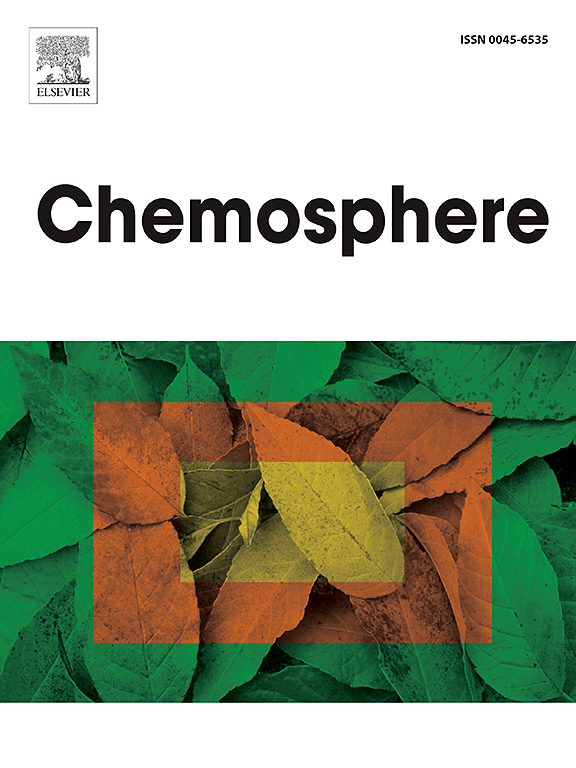Integrated use of histological and hormonal biomarkers to assess metal contamination in Leporinus friderici from mining areas in the Amazon
IF 8.1
2区 环境科学与生态学
Q1 ENVIRONMENTAL SCIENCES
引用次数: 0
Abstract
High natural concentrations of metals in Amazonian soils, combined with rainfall, increase metal availability in rivers and streams. This study objective was the environmental quality of two microbasins using integrated biomarkers in Leporinus friderici. Water, sediment, and fish samples were collected during the rainy and dry seasons from the Parariquara and Potiritá river microbasins, located near an area of mining in Paragominas, Pará, Brazil. Levels of Al, Fe, Cd, and Ti were measured, and plasma concentrations of E2, PROG, T, and 11-KT were evaluated. The results showed that Al and Fe were the most prevalent metals: mean concentrations in water were 0.80 ± 0.38 mg L−1 for Al and 1.22 ± 0.47 mg L−1 for Fe; in sediment, 6.03 ± 5.17 g kg−1 for Al and 3.75 ± 5.14 g kg−1 for Fe. Ti ranged from undetectable to occasionally present, while Cd was not detected. The pH remained acidic across both seasons. The dry season was the most critical for the fish, as it was associated with lower E2 (60.9 ± 57.3 pg mL−1) and higher 11-KT (25.17 ± 13.9 pg mL−1) levels, coinciding with elevated gonadosomatic index (GSI) values and increased concentrations of Al in the water. PROG and T remained constant in the environment. Al and Fe presents in the gonad possibly influenced the hormonal levels and in the gonad maturation, which explain the high frequency of the individuals in resting stage. Based on biomarker responses, the study indicates that L. friderici exhibits biological plasticity that allows it to persist in microbasins with elevated Al and Fe levels. Finally, we emphasize the importance of studies that monitor trace metal concentrations and fish health in streams, considering the ecological, geological and seasonal dynamics of the Amazon region.

利用组织学和激素生物标志物综合评价亚马逊矿区羊草的金属污染
亚马逊土壤中的金属自然浓度高,加上降雨,增加了河流和溪流中的金属可用性。利用综合生物标志物对两个微盆地的环境质量进行了研究。在雨季和旱季从位于巴西parpar Paragominas矿区附近的Parariquara和potirit河微流域收集了水、沉积物和鱼类样本。测量了Al、Fe、Cd和Ti的水平,并评估了E2、PROG、T和11-KT的血浆浓度。结果表明,Al和Fe是最常见的金属,Al和Fe在水中的平均浓度分别为0.80±0.38 mg L−1和1.22±0.47 mg L−1;在沉积物中,Al为6.03±5.17 g kg - 1, Fe为3.75±5.14 g kg - 1。钛从无法检测到到偶尔存在,而镉未检测到。酸碱度在两个季节都保持酸性。旱季对鱼来说是最关键的,因为它与较低的E2(60.9±57.3 pg mL - 1)和较高的11-KT(25.17±13.9 pg mL - 1)水平有关,与性腺指数(GSI)值升高和水中Al浓度升高相一致。PROG和T在环境中保持不变。Al和Fe在性腺中的存在可能影响激素水平和性腺成熟,这解释了个体在静息期的高频率。基于生物标志物响应,该研究表明L. friderici具有生物可塑性,使其能够在Al和Fe水平升高的微盆地中持续存在。最后,我们强调了监测河流中痕量金属浓度和鱼类健康的研究的重要性,考虑到亚马逊地区的生态、地质和季节动态。
本文章由计算机程序翻译,如有差异,请以英文原文为准。
求助全文
约1分钟内获得全文
求助全文
来源期刊

Chemosphere
环境科学-环境科学
CiteScore
15.80
自引率
8.00%
发文量
4975
审稿时长
3.4 months
期刊介绍:
Chemosphere, being an international multidisciplinary journal, is dedicated to publishing original communications and review articles on chemicals in the environment. The scope covers a wide range of topics, including the identification, quantification, behavior, fate, toxicology, treatment, and remediation of chemicals in the bio-, hydro-, litho-, and atmosphere, ensuring the broad dissemination of research in this field.
 求助内容:
求助内容: 应助结果提醒方式:
应助结果提醒方式:


